Ye Xia
Gemini Embedding: Generalizable Embeddings from Gemini
Mar 10, 2025Abstract:In this report, we introduce Gemini Embedding, a state-of-the-art embedding model leveraging the power of Gemini, Google's most capable large language model. Capitalizing on Gemini's inherent multilingual and code understanding capabilities, Gemini Embedding produces highly generalizable embeddings for text spanning numerous languages and textual modalities. The representations generated by Gemini Embedding can be precomputed and applied to a variety of downstream tasks including classification, similarity, clustering, ranking, and retrieval. Evaluated on the Massive Multilingual Text Embedding Benchmark (MMTEB), which includes over one hundred tasks across 250+ languages, Gemini Embedding substantially outperforms prior state-of-the-art models, demonstrating considerable improvements in embedding quality. Achieving state-of-the-art performance across MMTEB's multilingual, English, and code benchmarks, our unified model demonstrates strong capabilities across a broad selection of tasks and surpasses specialized domain-specific models.
SigLIP 2: Multilingual Vision-Language Encoders with Improved Semantic Understanding, Localization, and Dense Features
Feb 20, 2025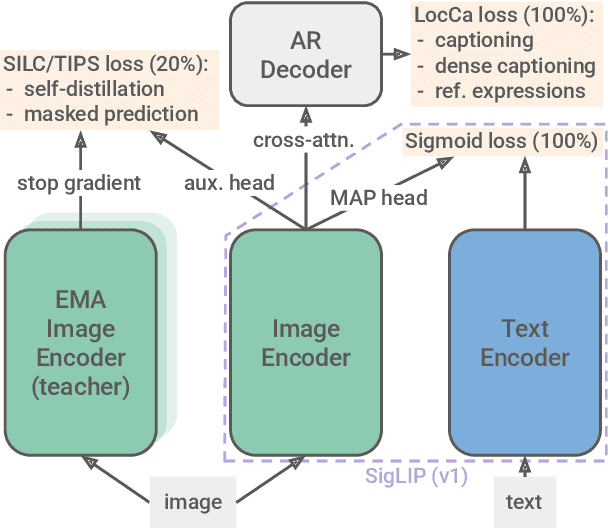
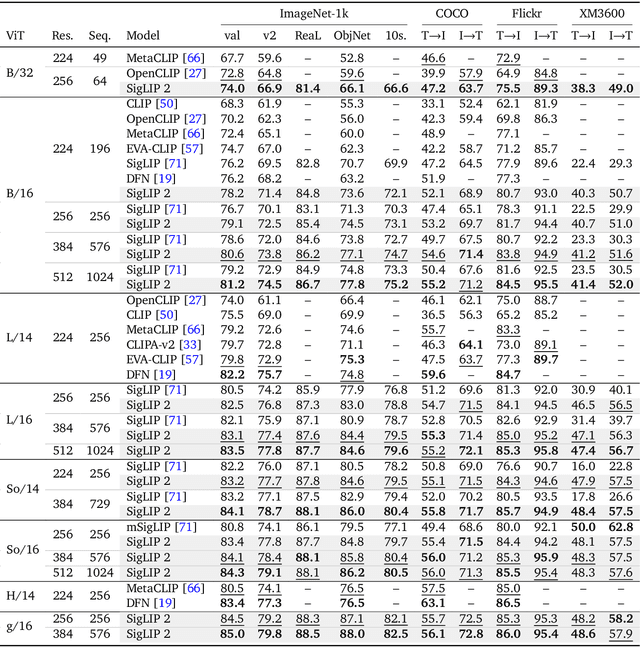
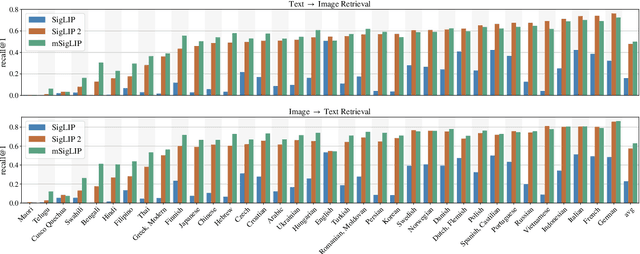

Abstract:We introduce SigLIP 2, a family of new multilingual vision-language encoders that build on the success of the original SigLIP. In this second iteration, we extend the original image-text training objective with several prior, independently developed techniques into a unified recipe -- this includes captioning-based pretraining, self-supervised losses (self-distillation, masked prediction) and online data curation. With these changes, SigLIP 2 models outperform their SigLIP counterparts at all model scales in core capabilities, including zero-shot classification, image-text retrieval, and transfer performance when extracting visual representations for Vision-Language Models (VLMs). Furthermore, the new training recipe leads to significant improvements on localization and dense prediction tasks. We also train variants which support multiple resolutions and preserve the input's native aspect ratio. Finally, we train on a more diverse data-mixture that includes de-biasing techniques, leading to much better multilingual understanding and improved fairness. To allow users to trade off inference cost with performance, we release model checkpoints at four sizes: ViT-B (86M), L (303M), So400m (400M), and g (1B).
Learning Visual Composition through Improved Semantic Guidance
Dec 19, 2024



Abstract:Visual imagery does not consist of solitary objects, but instead reflects the composition of a multitude of fluid concepts. While there have been great advances in visual representation learning, such advances have focused on building better representations for a small number of discrete objects bereft of an understanding of how these objects are interacting. One can observe this limitation in representations learned through captions or contrastive learning -- where the learned model treats an image essentially as a bag of words. Several works have attempted to address this limitation through the development of bespoke learned architectures to directly address the shortcomings in compositional learning. In this work, we focus on simple, and scalable approaches. In particular, we demonstrate that by substantially improving weakly labeled data, i.e. captions, we can vastly improve the performance of standard contrastive learning approaches. Previous CLIP models achieved near chance rate on challenging tasks probing compositional learning. However, our simple approach boosts performance of CLIP substantially and surpasses all bespoke architectures. Furthermore, we showcase our results on a relatively new captioning benchmark derived from DOCCI. We demonstrate through a series of ablations that a standard CLIP model trained with enhanced data may demonstrate impressive performance on image retrieval tasks.
Transferring self-supervised pre-trained models for SHM data anomaly detection with scarce labeled data
Dec 05, 2024Abstract:Structural health monitoring (SHM) has experienced significant advancements in recent decades, accumulating massive monitoring data. Data anomalies inevitably exist in monitoring data, posing significant challenges to their effective utilization. Recently, deep learning has emerged as an efficient and effective approach for anomaly detection in bridge SHM. Despite its progress, many deep learning models require large amounts of labeled data for training. The process of labeling data, however, is labor-intensive, time-consuming, and often impractical for large-scale SHM datasets. To address these challenges, this work explores the use of self-supervised learning (SSL), an emerging paradigm that combines unsupervised pre-training and supervised fine-tuning. The SSL-based framework aims to learn from only a very small quantity of labeled data by fine-tuning, while making the best use of the vast amount of unlabeled SHM data by pre-training. Mainstream SSL methods are compared and validated on the SHM data of two in-service bridges. Comparative analysis demonstrates that SSL techniques boost data anomaly detection performance, achieving increased F1 scores compared to conventional supervised training, especially given a very limited amount of labeled data. This work manifests the effectiveness and superiority of SSL techniques on large-scale SHM data, providing an efficient tool for preliminary anomaly detection with scarce label information.
TIPS: Text-Image Pretraining with Spatial Awareness
Oct 21, 2024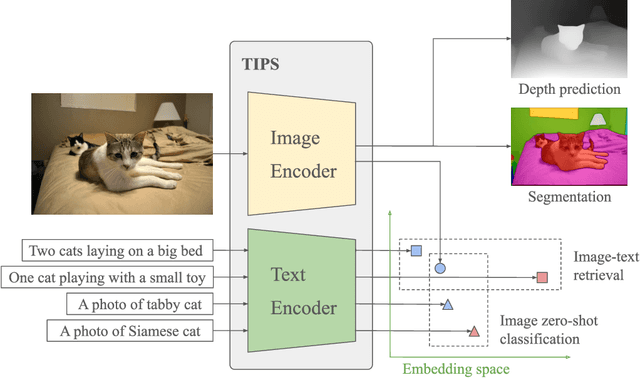
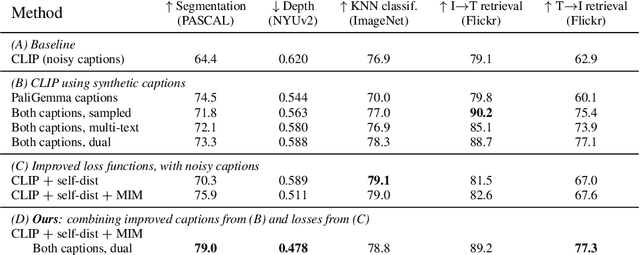
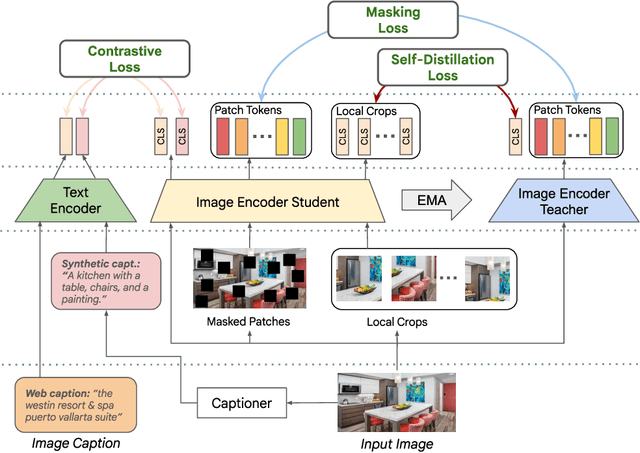

Abstract:While image-text representation learning has become very popular in recent years, existing models tend to lack spatial awareness and have limited direct applicability for dense understanding tasks. For this reason, self-supervised image-only pretraining is still the go-to method for many dense vision applications (e.g. depth estimation, semantic segmentation), despite the lack of explicit supervisory signals. In this paper, we close this gap between image-text and self-supervised learning, by proposing a novel general-purpose image-text model, which can be effectively used off-the-shelf for dense and global vision tasks. Our method, which we refer to as Text-Image Pretraining with Spatial awareness (TIPS), leverages two simple and effective insights. First, on textual supervision: we reveal that replacing noisy web image captions by synthetically generated textual descriptions boosts dense understanding performance significantly, due to a much richer signal for learning spatially aware representations. We propose an adapted training method that combines noisy and synthetic captions, resulting in improvements across both dense and global understanding tasks. Second, on the learning technique: we propose to combine contrastive image-text learning with self-supervised masked image modeling, to encourage spatial coherence, unlocking substantial enhancements for downstream applications. Building on these two ideas, we scale our model using the transformer architecture, trained on a curated set of public images. Our experiments are conducted on 8 tasks involving 16 datasets in total, demonstrating strong off-the-shelf performance on both dense and global understanding, for several image-only and image-text tasks.
Scaling Up Visual and Vision-Language Representation Learning With Noisy Text Supervision
Feb 11, 2021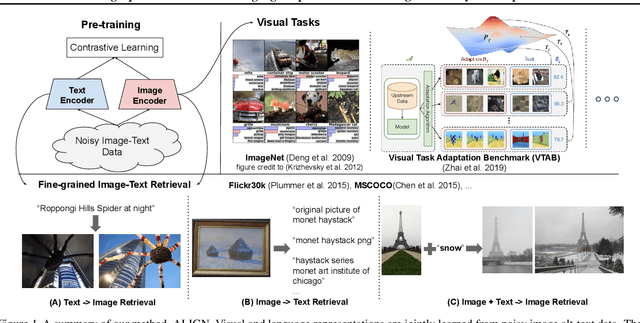

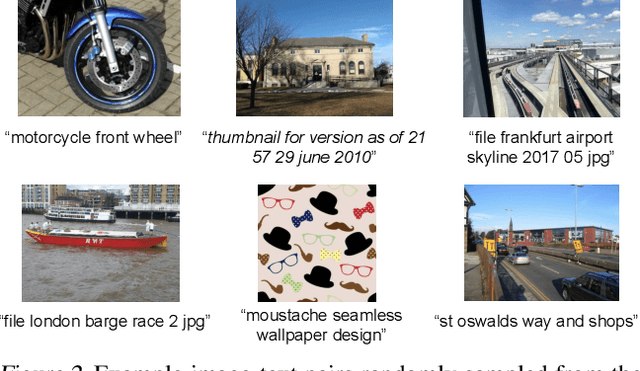

Abstract:Pre-trained representations are becoming crucial for many NLP and perception tasks. While representation learning in NLP has transitioned to training on raw text without human annotations, visual and vision-language representations still rely heavily on curated training datasets that are expensive or require expert knowledge. For vision applications, representations are mostly learned using datasets with explicit class labels such as ImageNet or OpenImages. For vision-language, popular datasets like Conceptual Captions, MSCOCO, or CLIP all involve a non-trivial data collection (and cleaning) process. This costly curation process limits the size of datasets and hence hinders the scaling of trained models. In this paper, we leverage a noisy dataset of over one billion image alt-text pairs, obtained without expensive filtering or post-processing steps in the Conceptual Captions dataset. A simple dual-encoder architecture learns to align visual and language representations of the image and text pairs using a contrastive loss. We show that the scale of our corpus can make up for its noise and leads to state-of-the-art representations even with such a simple learning scheme. Our visual representation achieves strong performance when transferred to classification tasks such as ImageNet and VTAB. The aligned visual and language representations also set new state-of-the-art results on Flickr30K and MSCOCO benchmarks, even when compared with more sophisticated cross-attention models. The representations also enable cross-modality search with complex text and text + image queries.
Periphery-Fovea Multi-Resolution Driving Model guided by Human Attention
Mar 24, 2019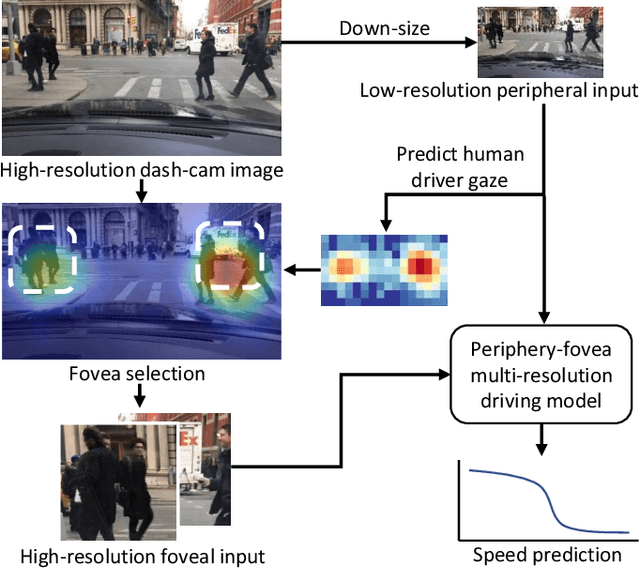
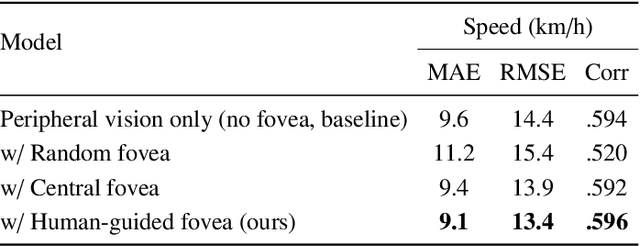
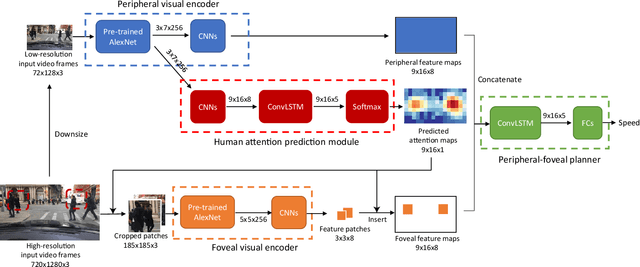

Abstract:Inspired by human vision, we propose a new periphery-fovea multi-resolution driving model that predicts vehicle speed from dash camera videos. The peripheral vision module of the model processes the full video frames in low resolution. Its foveal vision module selects sub-regions and uses high-resolution input from those regions to improve its driving performance. We train the fovea selection module with supervision from driver gaze. We show that adding high-resolution input from predicted human driver gaze locations significantly improves the driving accuracy of the model. Our periphery-fovea multi-resolution model outperforms a uni-resolution periphery-only model that has the same amount of floating-point operations. More importantly, we demonstrate that our driving model achieves a significantly higher performance gain in pedestrian-involved critical situations than in other non-critical situations.
Predicting Driver Attention in Critical Situations
Aug 16, 2018



Abstract:Robust driver attention prediction for critical situations is a challenging computer vision problem, yet essential for autonomous driving. Because critical driving moments are so rare, collecting enough data for these situations is difficult with the conventional in-car data collection protocol---tracking eye movements during driving. Here, we first propose a new in-lab driver attention collection protocol and introduce a new driver attention dataset built upon braking event videos selected from a large-scale, crowd-sourced driving video dataset. We further propose Human Weighted Sampling (HWS) method, which uses human gaze behavior to identify crucial frames of a driving dataset and weights them heavily during model training. With our dataset and HWS, we built a driver attention prediction model that outperforms the state-of-the-art and demonstrates sophisticated behaviors, like attending to crossing pedestrians but not giving false alarms to pedestrians safely walking on the sidewalk. Its prediction results are nearly indistinguishable from ground-truth to humans. Although only being trained with our in-lab attention data, the model also predicts in-car driver attention data of routine driving with state-of-the-art accuracy. This result not only demonstrates the performance of our model but also proves the validity and usefulness of our dataset and data collection protocol.
 Add to Chrome
Add to Chrome Add to Firefox
Add to Firefox Add to Edge
Add to Edge